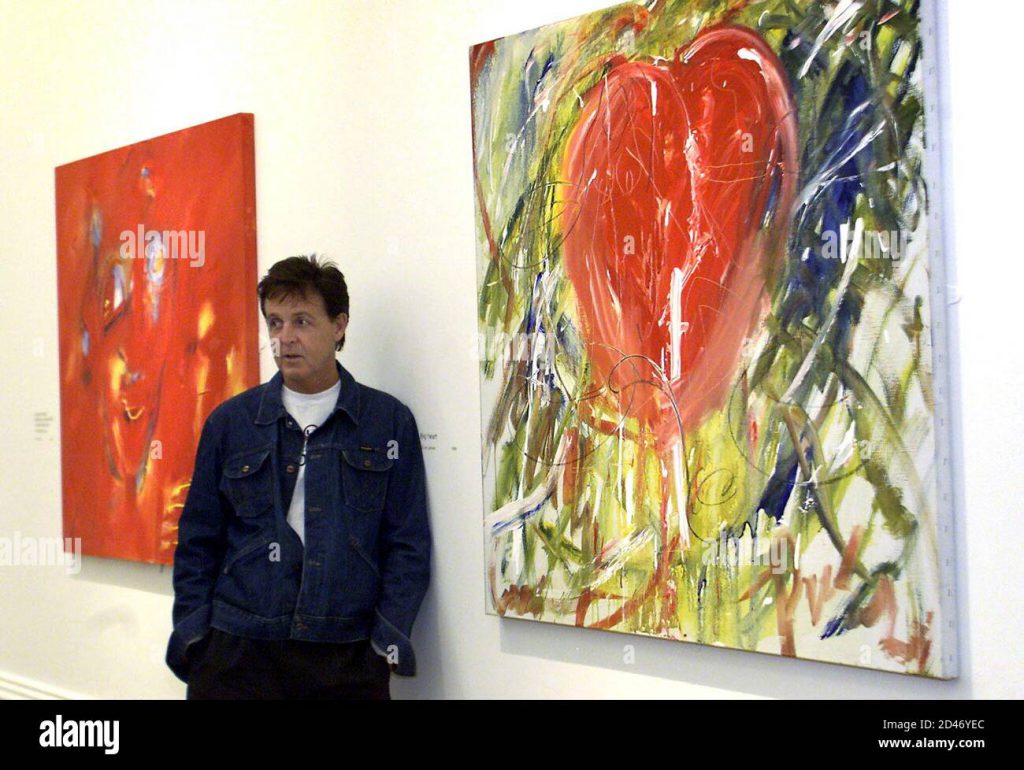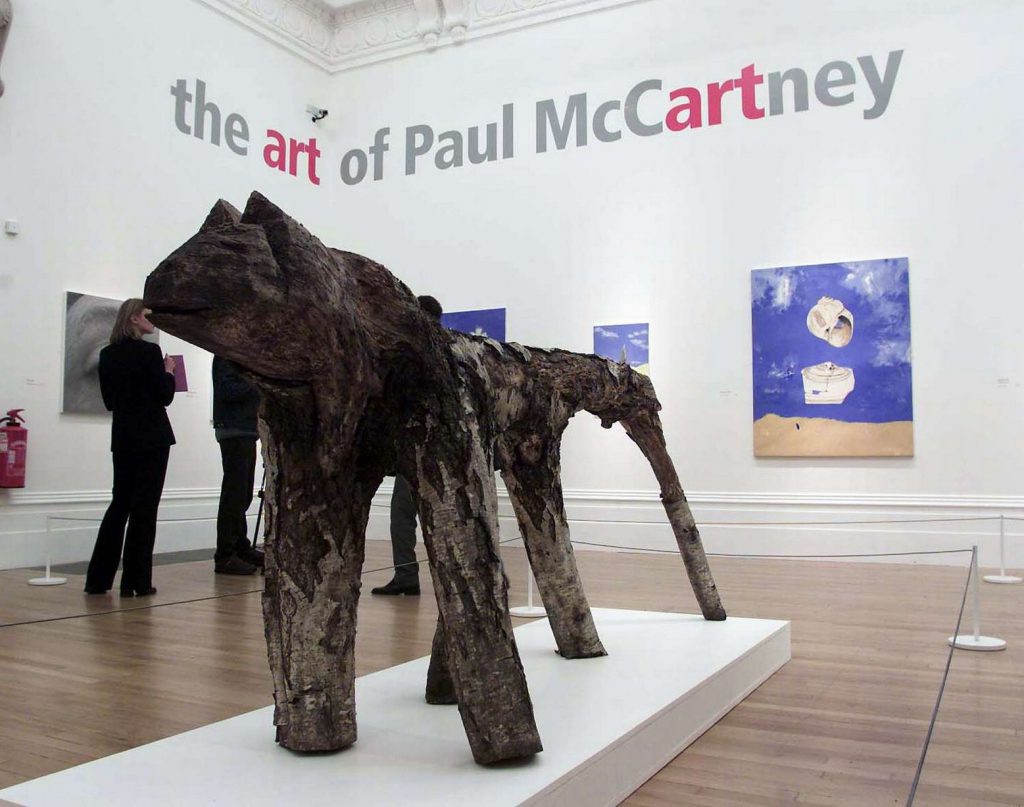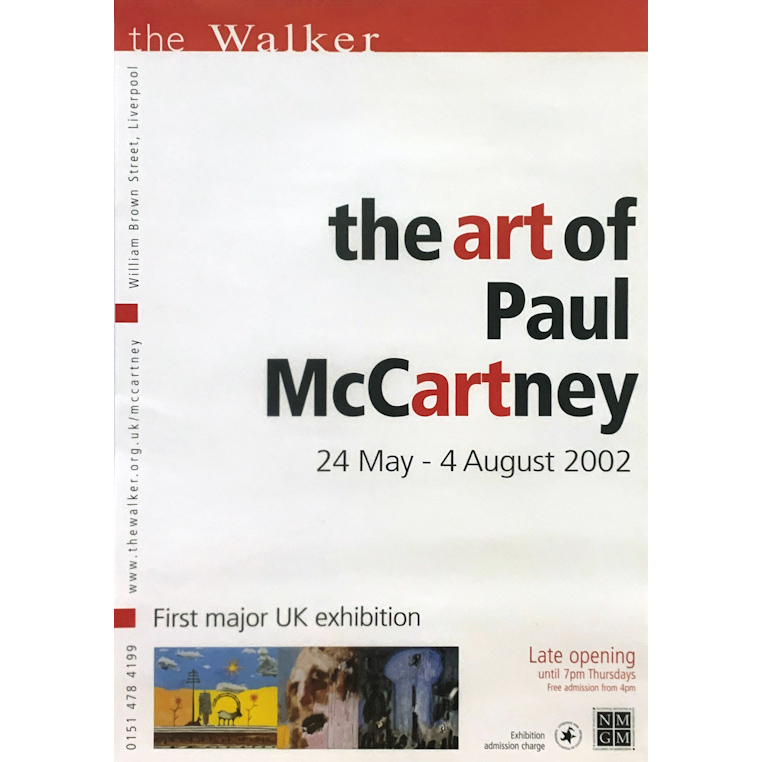Timeline
More from year 2002
Related articles
Spread the love! If you like what you are seeing, share it on social networks and let others know about The Paul McCartney Project.
About
From May 24 to August 4, 2002, Paul McCartney’s paintings and sculptures were exposed at Walker Art Gallery, in Liverpool. This was Britain’s first comprehensive exhibition of that facet of his art.
On July 25, 2002, Queen Elizabeth II visited the exhibition in presence of Paul McCartney and his wife Heather.
From The art of Paul McCartney | National Museums Liverpool (liverpoolmuseums.org.uk):
It is fitting that the first comprehensive exhibition of Paul McCartney’s paintings in Britain, should be at Walker Art Gallery, Liverpool – a mark of the affection and loyalty that Paul feels for his hometown. It’s an extraordinary show, highlighting the artistic talents of the world-famous musician, and revealing McCartney’s free-flowing creativity.
The exhibition includes more than sixty paintings created during the last twenty years. Many works in the show are new and have never been previously exhibited or published, including natural wood sculpture and photo pieces.
This highly varied collection shows Paul’s intuitive approach and love of free association. The paintings reveal a real sense of spontaneity and a natural empathy with the medium. They are a reflection of his humour, his inspirations, and the different periods in his life.
Paul is aware that he risks being seen as a ‘celebrity painter’ – a label that he finds uninteresting, but that he knows (as one of the most famous men in the world) it will be difficult to evade. His decision to exhibit comes from a genuine desire to progress as a painter – to do something new and challenging and to get a ‘little feedback’, just as anyone who has been painting seriously for twenty years might.
His aim is not to win critical acclaim but to further his artistic and creative output – to take risks, break conventions and flout expectations. It is a typical of a man who has already pioneered popular music, ventured into the genres of film, soundtracks and orchestral music and supports the wider arts industry through projects like the Liverpool Institute for Performing Arts.
Beginnings
Paul McCartney was inspired to pick up the paintbrush by the old adage ‘life begins at forty’. By his 60th birthday in June 2002, he will have been painting regularly for twenty years – but his relationship with art goes back to his childhood in Liverpool.
At school, Paul remembers being fascinated by the contents of the stationery cupboard – plain, blank paper and boxes of pencils that filled his head with dreams.
The idea of an empty background as a starting point – be it a white wall or clean canvas – is still a source of inspiration for Paul. He talks about the excitement and challenge of ‘killing the canvas’ or making the initial mark on the surface. It is interesting to note that the minimalist cover for ‘The Beatles’ (white album) was conceived by Paul with artist Richard Hamilton.
When he was eleven he used a school prize to buy his first modern art book, including works by Dali and Picasso. Then at fourteen he won an art prize for a drawing of St Aidan’s Church on the Speke housing estate where he lived. The church reappears in Paul’s 1990 painting, ‘Home territory’ along with his childhood homes in Western Avenue and Forthlin Road.
Early influences
In the early years of The Beatles, John Lennon and former member Stuart Sutcliffe attended art college. Paul consequently felt inhibited by his lack of formal art training – a block he only conquered later in life. The irony is, he didn’t have any formal music training either, but this failed to prevent him from becoming one of the most influential and pioneering songwriters of all time!
During the sixties he became friendly with art critic, John Dunbar and gallery owner Robert Fraser. Through their circle of influential friends and young artists, Paul became familiar with contemporary art, meeting people like Peter Blake and Richard Hamilton who were to later design covers for The Beatles’ albums. Sgt Pepper and Abbey Road were both based on ideas that Paul developed with them.
Paul would spend lots of time at the Fraser and Indica galleries, helping with the installation of exhibits and feeding his enthusiasm for the medium. He began collecting and bought a number of paintings by the surrealist painter Magritte, whose influence on Paul’s own painting is considerable.
A Magritte picture of a big green apple, bought by Paul from Robert Fraser became the inspiration behind The Beatles’ world-famous Apple logo. Linda McCartney later bought Magritte’s easel and spectacles for her husband, to encourage him to take up painting.
As one of the most charismatic figures of the day, Fraser worked with many exciting names in contemporary art and even introduced Paul to Andy Warhol. They spent the evening watching one of Warhol’s movies on Paul’s home projection system. Warhol appears in Paul’s 1990 painting, ‘Andy in the garden’.
Themes and inspirations
For Paul, much of his painting is to do with process – the application of the paint, the colours and textures evolving into composition. Many of the themes and titles are accidental and inspired by what happens on the canvas, particularly those of people.
He talks about Andy Warhol and John Lennon ‘appearing’ in his paintings. His ‘Bowie spewing’ came as the result of paint dripping down the canvas, when he noticed it looked like Ziggy Stardust.
Linda McCartney – or the essence of Linda – is the inspiration behind several of the paintings in the exhibition. In ‘Yellow Linda with piano’, her blonde hair and yellow top determines the theme, with all of the furniture and objects also painted in yellow. The same vibrant shades appear in ‘Linda yellow red cross’, where Linda is depicted with a red cross, a heart and a castle. She was also the influence for ‘Large yellow face’.
Works like ‘Brains on fire’, ‘Sea god’ and ‘Three blue faces in red sky’ combine the figurative and the abstract to evoke intense and powerful presences. There is a strong Celtic theme running through many paintings, influenced by Paul’s enthusiasm for the ancient and his own Celtic (Irish) roots.
Paul’s landscapes are infused with light and colour. Remote beach scenes like ‘Red triangle sand’ and ‘Beach towels’ are motivated by Paul’s time on Long Island. The theme of big open spaces recurs in his Arizona landscapes. As a man who has lived his life in the public eye, solitude is evidently inspirational and these pictures project a great sense of liberty and joy. […]
Paul and de Kooning
Paul credits the artist Willem de Kooning with being one of his greatest influences, as well as being a family friend. They met at the end of the seventies when de Kooning was a client of Linda’s father’s law firm.
Linda and Paul frequently visited the artist in his studio and Paul often became so fired up by the visits that he would go to the paint shop on the way home and buy all the same paints and canvases as de Kooning, or ‘Bill’ as he affectionately refers to him.
Paul remembers De Kooning’s attitude to his painting as a particular source of inspiration. One day he asked the artist what his painting was meant to be, to which de Kooning replied, “I don’t know, it looks like a couch, huh?” Paul found the remark profoundly liberating. In his own words, ‘he never looked back’.
John and I spent many a pleasant afternoon wandering around Walker Art Gallery when we were young, so going back to the ‘Pool with my paintings will complete some kind of circle for me and I’m really excited about it
Paul McCartney – From The art of Paul McCartney | National Museums Liverpool (liverpoolmuseums.org.uk)
I thought I would love to paint, I thought it would be very liberating for me, I had got a lot of visual ideas
Paul McCartney – From The art of Paul McCartney | National Museums Liverpool (liverpoolmuseums.org.uk)
I felt that only people who’d gone to art college were allowed to paint
Paul McCartney – From The art of Paul McCartney | National Museums Liverpool (liverpoolmuseums.org.uk)
Some of these faces might as well be landscapes because a lot of the time all I want to do is apply paint . sometimes just putting on the paint is more interesting than actually thinking what it all means
Paul McCartney – From The art of Paul McCartney | National Museums Liverpool (liverpoolmuseums.org.uk)




Last updated on December 22, 2023


Contribute!
Have you spotted an error on the page? Do you want to suggest new content? Or do you simply want to leave a comment ? Please use the form below!